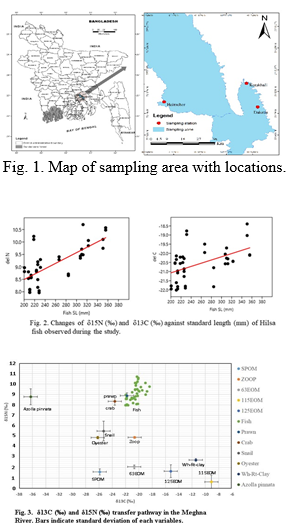BASAL SOURCES OF ENERGY AND THEIR TRANSFER PATHWAY FOR HILSA FISHES Tenualosa ilisha IN THE UPPER MEGHNA RIVER ESTUARY IN BANGLADESH
The stable isotope ratios (‰) of the hilsa fish species significantly varied according to their standard length in both δ13C and δ15N. It reveals that their food source and trophic level change as of their standard length. The map of δ13C and δ15N very interestingly expresses that benthic microalgal cells of 0-63µm is a primary basal source of energy for most of the Hilsa species in the study area.
The hilsa shad (Tenualosa ilisha) is the national fish of Bangladesh, being diverse in the south-east Asian and Persian Gulf region along with the Vietnam Sea and China Sea due to its diadromous migratory features. This species contribute more than 1% of GDP as a single fishery in Bangladesh. Hilsa is primarily planktivore species. However, no research could not conclude the type of source materials fuel primarily to Hilsa Fish. We applied stable isotopic signatures as a pioneer study to determine primary energy source materials and trophic relation to Hilsa fish.
δ13C (‰), δ15N (‰) ratio of suspended particulate organic matter (SPOM), organic matter (EOM) from five different sizes of sedimented benthic microalgae (0-63µm, 0-115µm and 0-125µm), periphyton (EOM-B in bamboo), aquatic weed (Azolla pinnata), zooplankton, snail, crab, prawn, and Hilsa fish (n=80) were analysed through Isotope Ratio Mass Spectrophotometry in the University of North Carolina, Wilmington in November, 2019.
Significant variation of δ13C and δ15N in Hilsa fish tissue and their standard length suggest that their food source and trophic level changes in line with their standard length (Fig 2). The map of δ13C and δ15N (Fig. 3) revealed that benthic microalgal cells of 0-63µm is a clear basal source of energy for Hilsa in the study area.
